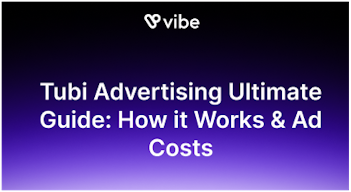OTT Performance Marketing: Evaluate the ROI of your CTV ads
What performance can you expect from your OTT Campaigns?
Online video streaming has overtaken traditional television; so much so that practically everyone now streams the content they want to watch through services like Netflix or Roku instead of having to watch whatever is on cable. Users get to choose what they are most interested in and, above all, they can watch it at their convenience rather than at a specific time, but doesn’t mean that TV as such is no longer relevant!
Just as connected TVs allow users to interact with internet content, TV content can now be accessed through any connected device, including smartphones, tablets, and computers. This new behavior toward video content warrants its own approach to advertising, which is where OTT performance marketing comes in. Here is what you need to know.
What is OTT in Advertising?
OTT – which stands for Over-The-Top – refers to TV content being accessed through the internet rather than traditional satellite or cable.
For your OTT performance to be optimal, you need to take into account not only connected TVs, but any device that runs an internet connection, including desktop and laptop computers, smartphones, and tablets. OTT advertising allows brands to target their audiences, to determine their ads’ viewing rates, and to measure these up against conversion rates.
Overall, users respond well to online advertising because they know it as a free alternative to the content and viewing limitations of traditional TV – on which ads are longer and more frequent anyway. For brands, OTT marketing is a great opportunity to increase consumer awareness and to generate significant ROI. Thanks to a host of customizable options, OTT enables targeted campaigns, highly relevant, location-based advertising.
Where are OTT Ads shown?
The frequency and interactivity of your CTV ads are determined by the streaming services such as Roku, Apple TV, Amazon Prime Video, etc. There are three main types of OTT video services:
- TVOD (Transactional Video-On-Demand) – pay per view
- AVOD (Advertising-Based Video-On-Demand) – free content with ads
- SVOD (Subscription Video-On-Demand) – paid content, ad-free
In terms of delivery, OTT ads offer three different options:
- Programmatic OTT, which serves ads across multiple networks and uses automation to deliver them through DSPs (Demand Side Platforms)
- Publisher Direct, where OTT service providers sell ad space to marketers
- Platform Direct, where OTT device providers sell the ads
Advertisers can define target audiences by gender, age, location, or interest, create a simple video ad tailored to their audience, and select the right format. OTT ads typically last 15 to 30 seconds.
The target audience also dictates which inventory should be used. CTV OTT ads can be sold across all CTV devices and OTT platforms in the form of banner ads, in-stream video ads, or sponsored content.
How effective is OTT advertising?
OTT performance relies heavily on overall channel viewership. With the rise in streaming channel subscriptions resulting from the confinement period during the COVID-19 outbreak, OTT advertising experienced a massive spike in performance.
Hulu alone now boasts over 46 million subscribers, while Roku has as many as 50 million. In addition to these, smaller providers cater to more specific audiences by focusing on such niches as horror or anime, as is the case for Shutter and Crunchyroll. This offers great opportunities for advertisers looking to target their ads as precisely as possible. Even better, OTT advertising allows advertisers to leverage consumer data to reach their audiences on a granular level.
As the name indicates, Over-The-Top ads are placed over the content the viewer wishes to watch. Users cannot skip to the main content, no window can be closed, and they can’t use ad blockers either, which makes them very effective.
What is a good CPM for OTT?
Part of OTT’s performance rests on its reliable return on investment. Thanks to real-time reporting, OTT advertising is extremely flexible (you can scale budget up or down based on your needs), but it also happens to be one of the least expensive solutions out there.
Marketers can expect to pay anywhere between $15 and $30 per 1,000 impressions (CPM).
How is OTT performance measured?
OTT performance can be measured in several ways. Some of the main KPIs to watch include ROAS (Return On Ad Spend), impressions, pacing, clicks, CTR (Click Through Rate), view through conversions, and walk-in conversions.
Because OTT ads are delivered through devices connected to the internet, OTT performance indicators abound, provided you opt for an OTT ad platform that gives you access to these data variables.
Start building your first OTT campaign
One of the main reasons OTT performances are so reliable is that marketers are not impeded by the complex process involved in traditional TV advertising. If you make sure to create your ads within the right specifications, then launching your own campaign only requires a few easy steps.
OTT performance ads are simpler to produce than ever, thanks to video-as-a-service platforms and marketplaces. This means that anyone can produce a high-quality video creative, which you can then upload to Vibe.co.
Select your targeting parameters and launch relevant display ads across connected devices to raise awareness about your brand and make your campaign memorable. Launch date, campaign goals, and budget are all up to you.
There are several ways to go about creating a successful OTT advertising campaign. OTT performance TV retargeting, for instance, uses first-party data to retarget users who show an interest in your brand by serving them your video ads on the big screen. Monitoring how users interact with your ads on other devices also allows you to keep them engaged. And if your aim is to target entirely new customers, then you can leverage third-party audience segments and either broaden or narrow your targeting efforts.
OTT advertising adapts to your needs and goals, offers accelerated launch times, and increases your overall return on investment.



